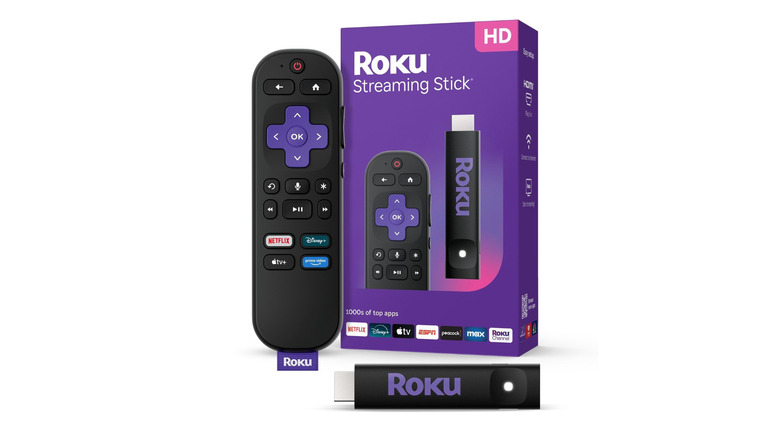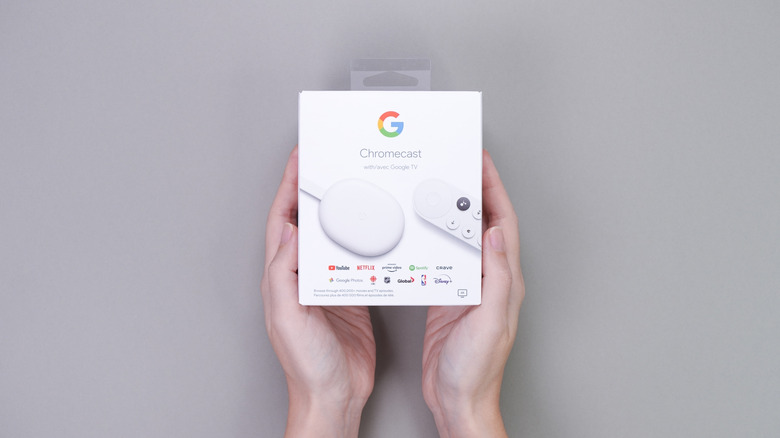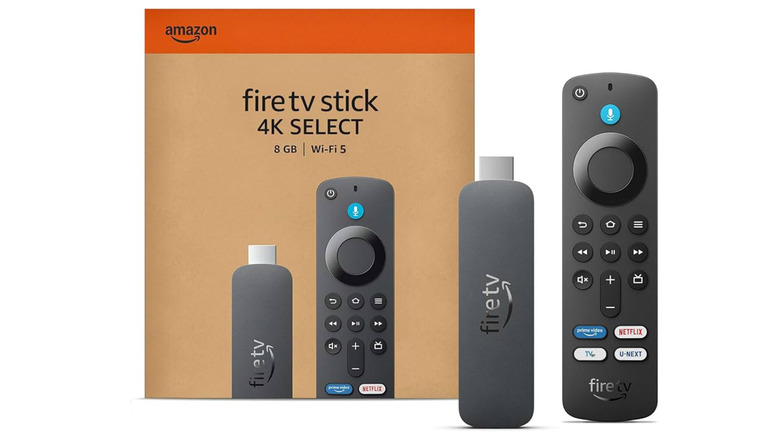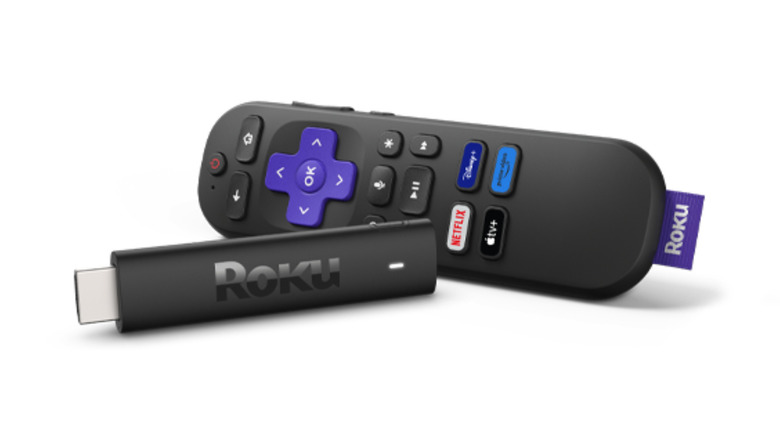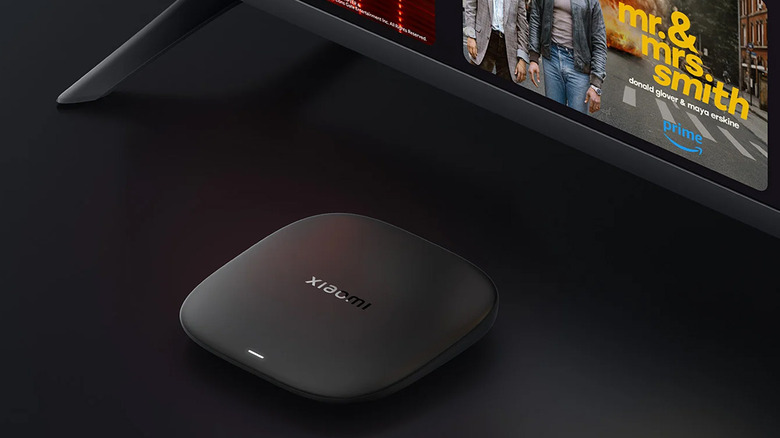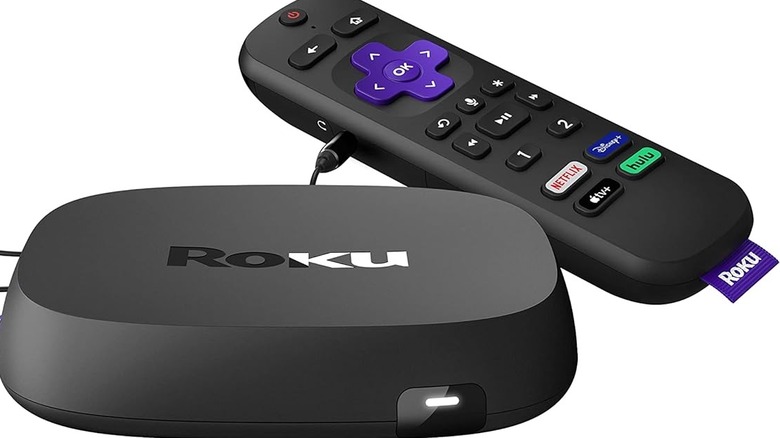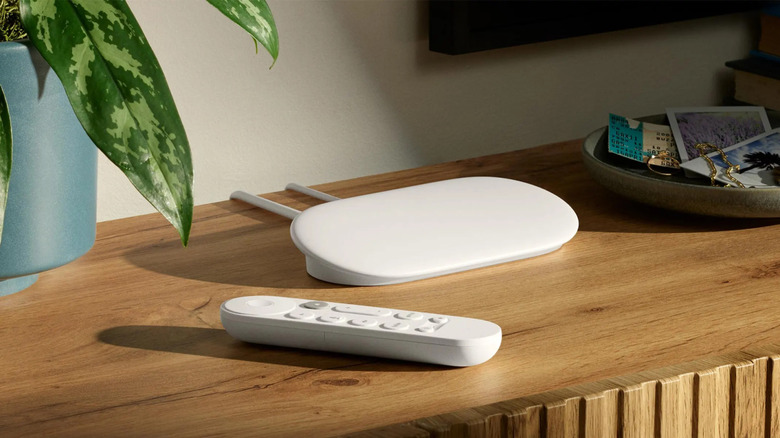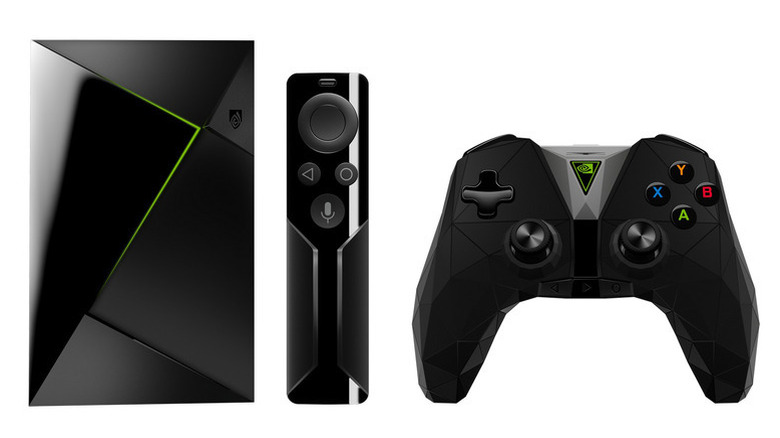Ranking 12 Major Streaming Devices From Worst To Best
We may receive a commission on purchases made from links.
While you might spend weeks agonizing over which TV or projector to buy for your home cinema, you probably don't give as much consideration to the streaming device — if any. After all, your shiny new TV likely has a built-in OS that hooks up to your favorite services, so why bother?
You shouldn't skimp on the streamer, though. Apart from video and sound quality, it's the next most important part of your home media experience, and a good streaming device will make all the difference. Even if you already have a "smart" TV, you'll always be better off with a streaming device. With wider app support, regular software updates, and more performant hardware, you'll get a more satisfying experience than sticking with whatever custom OS your TV manufacturer decided to provide. Replacing a streaming device with a newer one is also a great way to give a new lease of life to your old TV.
We've ranked these devices based on personal experience, system performance, user reviews, and overall ecosystem reputation — but you'll find more on our methodology at the end.
Roku Streaming Stick HD (2025)
Roku has a bit of a reputation as being the ideal platform for, let's say, more senior users. That's because Roku has the simplest, most intuitive interface of all. The app selection isn't nearly as extensive as Google or Apple platforms, but for a pure media experience, you'll find all the essentials as well as live TV channels.
Roku recently refreshed its line; the Express series is no longer available, but the Streaming Stick HD is the newest low-end budget option for HD-only non-HDR TVs. While the basic model still only supports 1080p output, the remote now has voice controls, and Apple Airplay support has been added. But we really can't fault the price. If you're looking at a Roku device because of the ability to pause over-the-air TV broadcasts, be warned that it's only Roku TVs that can do that, not the plug-in streaming devices.
Buy a Roku Streaming Stick 2025 HD edition for $24 at Amazon or Walmart.
Amazon Fire TV Stick HD (2024)
The Fire TV Stick HD is Amazon's budget-friendly entry in the streaming space, aimed at those who just want something simple that works. It won't be suitable for anything but the most basic of needs; it does support HDR, but only at HD resolution. There's no high-end audio with Dolby Atmos, either, but you do get an Alexa-powered voice remote and integration with your smart home. At around $35 it's remarkably good value, but some users report sluggish performance.
Like all Amazon devices, it's going to push you heavily toward Amazon content and a Prime subscription; you may be frustrated by built-in advertisements if you're not already a Prime member. There's also no Chromecast or Airplay features, so while there are workarounds for screen mirroring with third-party apps, it's clunky compared to the native casting experience that Apple or Google users might expect.
You'll find the Amazon Fire TV Stick HD at Amazon, sometimes for prices as low as $20.
Chromecast with Google TV 4K
Although still on shelves while stocks last, the Chromecast line is officially discontinued, replaced by the newer TV Streamer device. That doesn't mean a Chromecast 4K is a bad buy, as such, at the time of writing it has recently received a security patch, but these will only last so long. It's definitely showing its age, exhibiting issues with modern codecs like HEVC and AV1 that I've found make it almost useless for Plex. Performance is otherwise reasonable for most streaming tasks, but there's no Wi-Fi 6 support. The 8GB storage (of which only about half is usable anyway), fills up fast, with users frequently reporting issues installing updates.
I wouldn't recommend buying one at full price as your main streaming hub, but if you're heavily into Google and need a secondary device somewhere for YouTube or Netflix, it might be worth grabbing during a sale.
Amazon Fire TV Stick 4K Select
There are three models of Fire TV Stick 4K: the Select, Plus, and Max. The Select has a list price of $40, making it the cheapest Amazon entry point for 4K streaming; the Plus is essentially a rename of the previous Fire TV Stick 4K. The main difference is Dolby Vision support and Wi-Fi speeds. The Plus and Max support both Dolby Vision and HDR10+, while the Select is limited to only HDR10+. Wi-Fi support maxes out at Wi-Fi 5 on the Select, 6 on the Plus, and 6e on the Max.
Yes, it's confusing (even more so in the UK, where the standard 4K model has yet to be renamed to its Plus variant) — and there really doesn't need to be three different models of 4K Fire TV sticks. The main problem with the Fire TV Stick 4K Select or Plus is that while both are good value 4K streaming devices, the Max offers much better performance for only a fractionally higher price. As with any Amazon device, you'll get the best deals around Prime Day.
Roku Streaming Stick Plus / 4K
Great for travel, both the Roku Streaming Stick Plus and 4K include a special Wi-Fi mode for connecting to hotel and dorm networks that require a web login. The Plus and 4K models are broadly similar (despite the name, they both support 4K), though only the 4K supports Dolby Vision and has longer-range Wi-Fi. Neither is equipped with Ethernet. The Plus, 4K, and Ultra devices all feature Apple AirPlay and HomeKit integration, meaning you can automate your Roku system within Apple Home.
Also consider: the Roku Streambar SE. This one is a bit out there, but if you're looking for a soundbar for under $200 with the features of a Roku Streaming Stick Plus built-in, it might be worth considering the Streambar device to do the job of both. The Roku Streaming Stick Plus is available on Amazon for $30 at the time of writing.
Xiaomi TV Box S (3rd Gen)
Despite a limited presence in the U.S., Xiaomi is one of the largest TV brands globally, and this is its most popular streaming box outside of China. You'll get a pure Google TV 14 experience, with a snappy interface and all the expected live TV channels. It includes 4K Chromecasting, and has all the DRM certificates needed for the major platforms, like Netflix, Disney+, and Prime Video — something that cheaper "no name" devices often lack.
At under $80 (though it can often be found cheaper during sales), the Xiaomi TV Box S is what you should buy if you want a Google TV Streamer without paying the Google price. You'll get a powerful but barebones media player, supporting all the high-end 4K and audio codecs like Dolby Vision, Atmos, and DTS:X — but you will have to sacrifice Ethernet connectivity. The remote isn't as fancy either.
Roku Ultra
As we shift into the realm of boxes rather than sticks, the larger form factor means better performance, more storage for your apps, and optional Ethernet connectivity. Ethernet is a great option for more reliable streaming within your home network, but won't offer any speed benefits if you're streaming over the internet and already have decent Wi-Fi.
The Roku Ultra is the most powerful Roku box you can buy, for those who demand the best but want to stick within the Roku ecosystem. The UI is snappier than the Roku sticks, but the box itself doesn't have many extra features compared to the top-of-the-line stick. Both support 4K HDR and various high-end codecs, while only the Ultra supports Dolby Atmos. The Ultra also has Wi-Fi 6, an Ethernet port, and USB (for local media playback).
It's actually the remote control that ships with the Ultra where you'll find the most upgrades. You can recharge the remote with USB-C rather than having to change batteries, use hands-free voice control, trigger a "lost mode," and it has additional buttons for live TV and to Quick Launch your favorite app. You'll find the Roku Ultra on Amazon for $80.
Google TV Streamer 4K
The pebble-like Google TV Streamer 4K is Google's newest device, replacing the Chromecast line. At under $100, it's great value for money with support for the full range of 4K HDR and high-end audio codecs. The Ethernet port offers fast connectivity, and there's even a handy "find my remote" button on the Streamer. For Google fans, it's the natural choice.
It includes smart home integration, such as the ability to watch your security camera or doorbell feeds, as well as being able to control your smart devices. It also acts as a Thread Border Router, so if building out a Thread network is high on your list of requirements and you don't want to pay the Apple tax, the Google Streamer should be your top choice.
There are plenty of live TV integrations, as well as thousands of Android TV apps to cover every media requirement you might have. As part of its "Gemini all the things" strategy, Google is pushing AI features heavily, which you'll either love or hate. Right now, it can be used for summaries of content, pulling in reviews, or generating your own custom screensavers; though who knows what Google will roll out in future. Don't get too attached, either: entire websites exist to keep track of products that Google has killed off. You can buy the TV Streamer directly from Google, Amazon, or Walmart.
Amazon Fire TV Stick 4K Max
While the 4K Select and 4K Plus Fire TV Sticks were launched in 2025, the Max model was last refreshed back in 2023. However, the Plus and Max models have a lot more in common, including price, at only $50 and $60 respectively. Both offer excellent streaming performance with Wi-Fi 6 or 6e, along with broad codec support.
The 4K Max version is the only Fire TV Stick to feature the Alexa Voice Remote Enhanced, which adds some handy shortcut buttons for "recents" and live TV channel hopping. It's also the only Fire TV Stick that supports Ambient Experience, which turns your TV into a smart display for art, photos, and customizable widgets. Amazon has also been found to inject ads into your screensaver, however.
At $60 direct from Amazon, it's still great value and the best performance you'll get from the minuscule stick format. The only reason we haven't added the Fire TV Stick 4K Plus to this list is because at only $10 more, the Max offers better performance and features, making the Plus largely redundant.
Amazon Fire TV Cube (3rd gen)
The Fire TV Cube combines a streaming device and a hands-free Alexa in one, so you won't need to press a button on the remote for voice control of your TV or smart home. You can even go one step further, and subscribe to the upgraded Alexa Plus assistant service. As the only Fire TV device with HDMI input, you can even plug in your cable box and use voice commands to change the channel.
It's twice as powerful as the Fire TV Stick 4K Max, and offers an Ethernet port as well as Wi-Fi 6e for the ultimate in reliable streaming. The extra processing power you get from the larger package isn't just for a snappier UI though; you'll get less buffering, and can use the Super Resolution upscaling feature to make older HD content look sharper on your 4K TV.
While it's fine for basic Alexa commands, we wouldn't recommend the Fire TV Cube as your primary Alexa device: reviews note the built-in speaker quality isn't great and audio connectivity can be buggy. You'll want to keep your TV or soundbar for music streaming. Despite technically being more powerful, the Fire TV Cube also doesn't support Ambient Experience like the Fire TV Stick 4K Max does, which seems like a curious omission that will hopefully be fixed in a software update. At $140 from Amazon, the Fire TV Cube is quite pricey, but good value if you'd otherwise be buying an Echo as well. If you're not interested in the Alexa features, the Fire TV Stick 4K Max is the better choice.
Nvidia Shield TV Pro
The NVIDIA Shield TV Pro is the enthusiast's system of choice, though it's also the bulkiest option on this list; it veers more into the territory of "mini PC" than strictly a streaming box. It's ideal for custom setups such as a Plex server, thanks to external storage, and the image quality is outstanding with the best-in-class post-processing and AI-upscaling to 4K 60fps. Naturally, it also supports NVIDIA's own GeForce Now cloud gaming service (and there's a GeForce Now ad-supported free tier) — but you'll need to bring your own controller with the latest version of the device, as it's no longer included.
Rather than develop a custom OS, the NVIDIA Shield TV Pro runs Android TV, which means you get access to the full Google library of apps and Chromecast features. It's not as plug-and-play as other options, but what you sacrifice for usability you get back in spades when it comes to performance and customization. The NVIDIA Shield TV Pro can be bought for $200 at Amazon or Walmart.
Apple TV 4K (3rd gen)
The Apple TV 4K is the default top choice for Apple users, with a simple but clean tvOS that doesn't feel like it's constantly begging you to subscribe to additional services. By default, Apple TV+ shows will be promoted on the homescreen, but you can move your favorite apps up to the top; if supported, content will be pulled from those instead. The Apple TV 4K isn't just a streaming device, though. Like the Google Streamer, it also acts as a home hub and Matter controller — essential if you want to build out a modern smart home, allowing for automation and remote access. But, if you're buying for the Matter over Thread feature, be careful, because there are actually two versions of the Apple TV 4K: one with an Ethernet port, and one without. Only the former comes with a Thread network radio.
While there might not be as many apps available as on Android, what you do find will generally be more polished, and there's enough power in the Apple TV 4K for some pretty advanced gaming. Like the Google Streamer, Apple includes system-level dialogue enhancement, too. The Apple TV 4K is one of the priciest options on this list at $150 from Apple, but unlike Google or Amazon, Apple isn't tracking your every move to help sell you more stuff and provide personalized advertising. The only reason not to buy an Apple TV 4K is that there might be a new one coming before the end of 2025.
How we ranked these devices
We ranked these devices based on hundreds of hours of personal experience, combined with expert and user reviews. All these streaming devices support all the streaming services, so you won't struggle with any if you want to watch mostly Netflix or YouTube. But while you can watch Apple TV+ on a Google TV Streamer if you really want, you'll always get deeper integration on an Apple device. The same is true of YouTube: Of course, you can watch YouTube on an Apple TV, but you won't get video previews as you hover on each video, or content discovery on the homescreen. Therefore, it's worth thinking about your biggest use case.
Deep in the Apple or Google ecosystem? Go for an Apple TV or Google TV Streamer, respectively. Want the widest choice of apps? Opt for a device with Android TV: either the Google TV Streamer, or an NVIDIA Shield. Buying for your parents or just hate messing around? Roku offers the simplest interface. Opt for either the Ultra or a Roku Stick, depending on how much performance you need, or how likely you are to watch 4K Dolby Vision or other advanced codecs. Read our complete Roku buying guide first. Buying primarily for Plex or Kodi? The Nvidia Shield Pro is your best bet.

